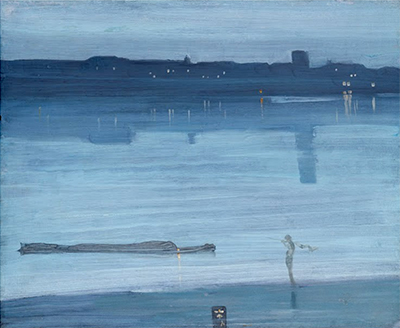Nocturne: Blue and Silver – Chelsea was executed by James Abbott McNeill Whistler's in August 1871, and it's the first of the London Nocturnes by the artist. The artwork appears to have influences from Oriental art.
Typically, the connection to Chinese paintings and Japanese prints is marked by James' in the middle of the painting at the bottom edge, where he has used the 'butterfly' signature. In this painting, the artist was aiming to convey the Thames' sense of beauty and tranquillity by night. Frederick Leyland was the one who first used ‘nocturne’ to describe moonlit scenes by James. It aptly implies a night scene notion, but with musical associations. James quickly adopted the expression and later explained stating that by using the name ‘nocturne’, he wished to show an artistic interest alone, stripping the painting of outside anecdotal interests that might have been attached to it.
On the evening of August 1871, while he was returning from his trip by steamer to the City of Westminster, the artist was inspired by a beautiful view of the river one hour before sunset in a glow of unique transparency. James immediately went to his studio and started painting a sunset together with the moonlit scene at a single sitting. In November 1871, the painting was exhibited at the Dudley Gallery together with James' Variations in Violet and Green.
The painting was painted on panel and primed mainly with dark grey paint. The artist used thin layers of pigment and created a beautiful contrasting sense of luminosity. This view is from Battersea district looking across to Chelsea, an affluent area of West London, and one can see the features on the horizon, like on the right, the tower of All Saints. The fisherman's figure and a low barge in the foreground are indicated. The influence of Japanese prints is also evident in the economy of line and the restricted palette.
When it was exhibited at the Dudley Gallery, the Times critic showed a rare appreciation of James' Nocturnes and described them as examples of the theory that art is closely related to music. He stated that a painting shouldn't aim at expressing recording facts of nature, depicting incidents of history or expressing dramatic emotion, but should be gratified with peoples moods and stirring their imaginations, by detailed combinations of colour. He pointed to the pictures as proof of James' talents as a draughtsman and admired the new approach, which he believes is original.




